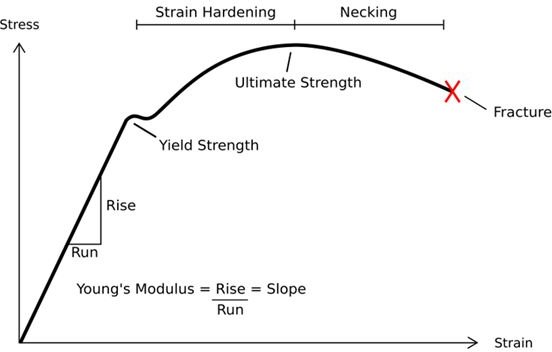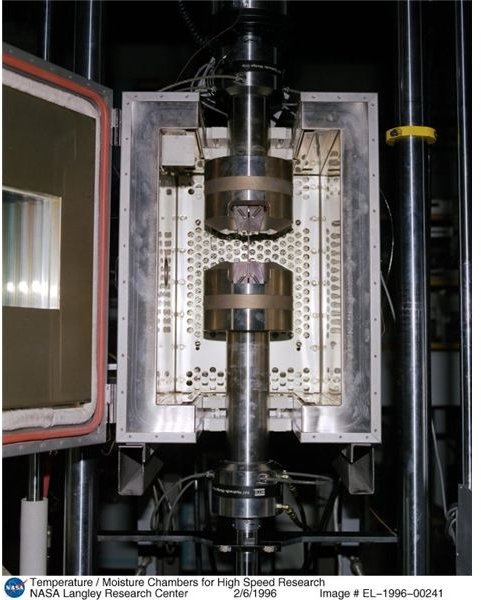Desirable Mechanical Properties Of Engineering Materials
Mechanical Properties, Tests And Procedures
Mechanical properties are characteristics of materials that are revealed when that material is subjected to mechanical loading. There are standard tests and procedures that are performed in a materials laboratory in order to determine the mechanical properties
Determining Mechanical Properties with a Tensile Test

Tensile properties indicate how the material will respond to forces being applied in tension. A tensile test is an essential mechanical test where a thoroughly prepared specimen is loaded in a controlled technique while measuring the applied load and the elongation of the specimen over some distance. The diagram here shows the results of a tensile test. Diagrams like this are used to determine the modulus of elastic limit (Young’s Modulus), elasticity, proportional limit, elongation, reduction in area, tensile strength, yield strength, yield point, and other tensile properties.
Yield Strength
The yield strength or yield point of a material is defined in materials and engineering science as the stress at which a material starts to deform plastically - meaning the material deforms permanently. Preceding to the yield point, the material will deform elastically and will come back to its original shape when the stress is removed. The slope of the elastic deformation region is actually the Young’s Modulus of the material, a measure of its elastic deformation. When the yield point is crossed some part of the deformation will be permanent and non-reversible. Details regarding the yield point is important when designing a component since it normally represents an upper limit to the load that can be applied. It is also important in many materials production techniques such as rolling, forging, or pressing. In structural engineering, this is a soft mode of failure which is not usually a source of catastrophic failure or ultimate failure.
Ultimate Tensile Strength
It is the maximum stress that a material can undertake. It measures the magnitude of stress applied to a material at its breaking point or the point at which it fails. The tensile strength of a material is the point at which a material, under the stress of an applied force, breaks or can no longer maintains its structural reliability. It is, in other words, the extent of force the material can resist without breaking.
Necking
Under constant tensile deformation, some materials (especially polymers) may deform disproportionately, forming a “neck”.
Fracture
After necking, the applied stress will result in the breaking of the material (point of fracture).
Desirable Mechanical Properties
Ductility
It is the ability of a material to undergo large plastic deformation without cracking or shattering. This is the property that allows the material to be drawn out into a thin wire.
Resilience
It is the ability of a material to store elastic energy, which is also called modulus of resilience. This property is important when selecting a material for spring manufacturing.
Toughness
It is the ability of a material to withstand sudden loading or to absorb energy until it breaks and it is measured in terms of modulus of toughness. Machine components that are subjected to sudden loading must be made from materials that possess high toughness.
Hardness
It is the ability of a material to resist scratching, abrasion or indentation. It is one of the easiest criterion or measurement in acceptance tests, and quality control of raw stock as manufactured products. Common hardness testing methods are Brinell and Rockwell hardness tests.
Other Characteristics/Properties
Impact Strength
It is a measure of the ability of a material to withstand shock loading, and can also be described as the energy required to fracture a given volume of material. It is measured by an impact machine. Types of impact tests are Charpy and the Izod.
Metal Fatigue
The number of cycles for which a component or a specimen can endure an alternating load mainly depends upon the magnitude or amplitude of that load. The greater the magnitude of the alternating load, the lesser the number of cycles after which it fails. Magnitude of the load that is the basis of failure, is much less than the yield stress of the material, indicating that the mechanism of failure is different from one in which the specimen is subjected to uniaxial tension. This phenomenon is called metal fatigue, and the failure is due to initiation and then propagation of a crack within the part.
Plasticity
It is the ability of the material to deform plastically at elevated temperature under constant load. It occurs even though the applied stress is less than the yield stress at that temperature. Creep characteristics are determined by subjecting the specimen to different constant stresses at elevated temperatures and observing the corresponding strain.
Brittleness
It is the ability of the material to shatter or break before deformation (eg. iron, glass). This property is actually the opposite of plasticity.
Tensile Test Facility

Image Credits
Typical Stress vs. Strain diagram for a ductile material (e.g. Steel).